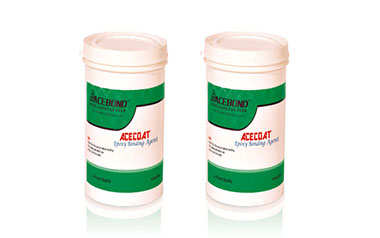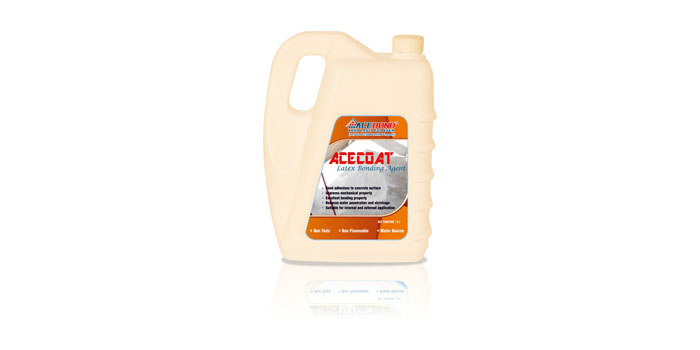
Products
Acecoat-Latex Bonding Agent
Description
Superior quality latex admixture designed for mix with 2 parts of portland cement and 1 part of fine silica sand at site before application. The slurry made with Acecoat Latex Bonding Agent, cement and fine silica sand bonds concrete, plaster or masonry to difficult surfaces such as dense, slick or porous concrete, stone, drywall, hardboard and plaster walls. It improves the adhesion and increases the resiliency and elasticity of the patch. It is ideal for repairing and repointing masonry parging walls, resurfacing concrete driveways, patios, slabs and steps. The slurry may also be used to prime plaster cracks by brushing into the crack before filling with plaster. Acecoat Latex Bonding Agent slurry provides a long lasting, tight bond of the patch to the original surface helping to extend the life of the repaired area.
- For interior and exterior application
- Bonds to both damp and dry masonry
- Bonds concrete and plaster to difficult surfaces
- Add to patching cement, increases resiliency and elasticity of patch
- Improves performance of powdered waterproofers
Uses:
Bonding new concrete or repair mortars to existing concrete. Bonds masonry to masonry and concrete and plaster to difficult surfaces. Also makes cement, stucco and plaster adhere better
Mixing
Add required amount of Portland cement to the Acecoat Latex Bonding Agent while mixing (Approx 10kg Portland cement and 5kg silica sand to 5 litre Acecoat Latex Bonding agent). Mix thoroughly with a low-speed (300–600 rpm) drill and mixing paddle for 3 minutes, scraping unmixed material from sides and bottom of mixing container as needed. Avoid entrapping air into mixture.
Remove all standing water by vacuum or blowing with oil-free, compressed air prior to installation. Acecoat Latex Bonding Agent can be installed on damp or dry surfaces. Do not install through standing water. Avoid installing at high temperatures or windy conditions to maximize open time. Never apply in direct sunlight. Apply slurry made with Acecoat Latex Bonding Agent by brush, roller, spray or squeegee. Immediately install repair materials or concrete mix into wet Acecoat Latex Bonding Agent. Do not allow slurry to dry or become tack-free before concrete or mortar installation. If Latex Bonding Agent does dry or becomes tack-free, abrade surface and recoat. Do not apply more bonding agent than can be effectively covered with repair mortars or concrete mixes while remaining wet.
Surface preparation
Concrete surface must be sound, clean and free of all contaminants that could impair product adhesion, bond or performance. Concrete should be a minimum of 28 days old or substantially cured to the equivalent design strength prior to installation. Remove all loose or deteriorated concrete by chipping hammer, water jetting, or other mechanical means to achieve an open pore structure and sound concrete surface. Remove all cleaning media and debris by vacuum or blowing with high-pressure, oil-free air.
For OLD CONCRETE: Thoroughly clean surface with a grease-cutting detergent to remove grease and oils, and remove any loose or unsound concrete by chipping, scarifying, shotblasting, sanding, or grinding. Proceed as for new poured concrete.
For PREVIOUSLY COATED CONCRETE: Remove any peeling or degraded paint by sanding or using a paint stripper. For intact paint, thoroughly clean the surface with a strong detergent, then lightly sand to remove any gloss. Treat any areas worn down to the original concrete as bare concrete.
Pack size:
Available in 1 litre, 5 litre and 20 litre
Shelf life:
12 months, if stored in cool and dry area in unopened containers, protected from sun light. Shelf life is calculated from the month of manufacturing of the product.
LIMITATIONS
- It is not recommended to use on surface where continuous temperature exposure above 100°C.
- Not recommended in some manufacturing facilities where heavy chemicals are used. Consult Technical Services on questionable installations.
- Colours may be slightly different than shown. When colour considerations are critical, a mock-up should be constructed prior to final application.
PROTECTIVE MEASURES:
The use of safety glasses and chemically resistant gloves is recommended. Use appropriate clothing to minimize skin contact. The use of a NIOSH-approved respirator is required to protect respiratory tract when ventilation is not adequate to limit exposure below the PEL. Refer to Material Safety Data Sheet (MSDS) available at msds for detailed information.
Related Products


